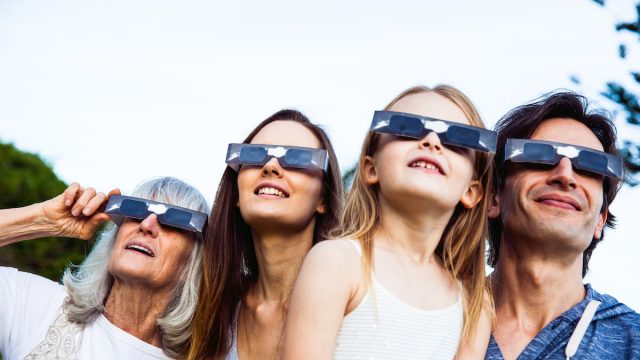Why You Shouldn’t Wear Black, White, or Gray During the Eclipse, Science Says
Total solar eclipses are few and far between, but on April 8, 2024, stargazers will get the chance to witness a spectacular yet rare astronomical event. The highly anticipated eclipse will be the first of its kind in nearly seven years and it isn’t expected to come back around for another two decades.
The National Aeronautics and Space Administration (NASA) has been busy instructing novice onlookers that they must use specialized eye protection, like eclipse glasses or a safe handheld solar viewer, during the partial phases. But other organizations say that in addition to proper eyewear, bystanders should also put extra thought into their eclipse-gazing outfit, particularly as it pertains to color.
RELATED: Here’s How Much of the Total Solar Eclipse You Can See in Your Region.
If you’ve been researching or preparing for the upcoming spectacle, you’re probably familiar with the phrase “path of totality.” Those located within this distinct path will get to witness the moon pass between the sun and the Earth, and as a result, be able to catch a glimpse of the sun’s corona, or outermost layer, explains NASA.
Similar to the moon’s shadow, other neutral colors such as black, white, or gray will also resemble the sky’s darkness during the path of totality. Meanwhile, colors similar to the sun like red and orange, as well as earthy tones like blue and green, will take on a different appearance. This is called the Purkinje effect.
According to WION, the Purkinje effect is an occurrence in which “the sensitivity of the human eye to different colors changes under different lighting conditions, particularly during the transition from daylight to twilight.” As a result, red and yellow colors begin to fade, whereas shades of green and blue begin to pop or appear brighter.
Viewers will get to experience this first-hand when the eclipse is at peak visibility, and wearing a colorful shirt is an easy way to test the theory.
RELATED: 8 Best Destinations for the Next (and Rare) Total Solar Eclipse.
“This Purkinje effect during the coming eclipse will turn the whole experience from just watching the sky go dark to a real-life science demo on your clothes,” said online retailer Solar Eyeglasses, per WION.
As the moon’s shadow invades the sun’s brightness, similar “warm” colors also become less visible. For example, those wearing red and orange will appear to be dressed in gray, WION explains. If the person next to you is wearing blue or green, you’ll see their clothes getting increasingly more noticeable.
If you’re hoping to test the Purkinje effect out for yourself, experts tell WION that you shouldn’t wear black, white, or gray as the scientific method works best with bright, bold colors.
